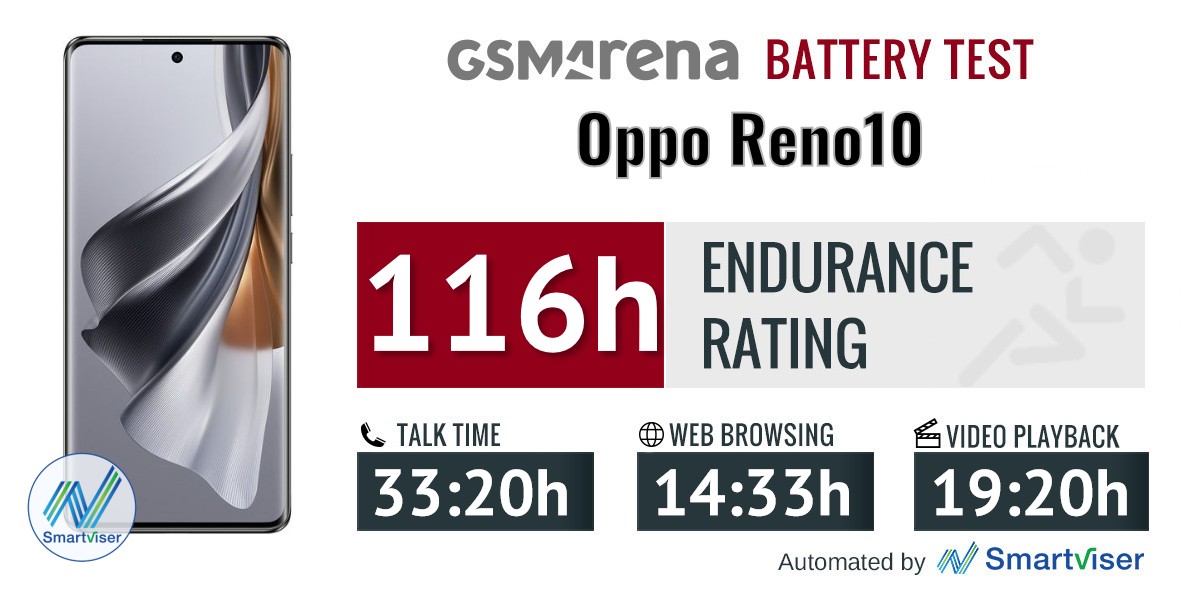Oppo Reno10 review

6.7-inch 120Hz AMOLED display
The display is definitely one of the highlights of the Reno10. It is actually quite similar to the one on the Reno10 Pro. The phone is rocking a big 6.7-inch curved AMOLED panel. It has a resolution of 1080 x 2412 pixels, which means a pretty standard 20:9 aspect ratio and a pixel density of around 394 ppi. That's perfectly sharp in person.

Oppo claims that the Reno10 should be able to do around 500 nits of typical brightness, 800 nits of maximum on the entire display and 950 nits of peak brightness. In our testing, we measured 502 nits of maximum brightness with the manual brightness and 811 nits maximum in auto mode, so given the differences in testing methodology, the advertised numbers do check out. In practice you'll have no trouble using the Reno10 outdoors, although it's not going ot be quite as colorful as the best screens out there.
Thanks to its AMOLED tech and perfect deep blacks, the panel on the Reno10 effectively has infinite contrast. It can also get very dim at a minimum brightness of 2.2 nits at white point.
Unlike the Reno10 Pro, the vanilla Reno10 only has a couple of color modes to choose from. Vivid color mode is the default and aims for the DCI-P3 color space and covers it rather well, but it is not terribly accurate with a pronounced cold cast. Then there is the Natural mode, which aims for the sRGB color space and again does much better with the coverage than the accuracy. We tried adjusting color temperature with the provided slider to offset the cold cast, but that didn't really help with overall color accuracy.
The Reno10 has a 10-bit panel. That translates to less color banding thanks to the ability to reproduce a whopping 1 billion plus colors. The display is also HDR10+ certified. On a software level, the phone can decode HDR10, HDR10+ and HLG, but not Dolby Vision.



HDR support • Netflix playback capabilities • DRM
We are also happy to report that it is certified for the highest possible Widevine L1 DRM, which allows streaming services like Netflix to offer up FullHD streams.
Just like its Pro sibling, the regular Reno10 has its own optimization engine baked in, called the 01 Ultra Vision Engine. Unlike the Pro model, however, the vanilla only has a single option here - Video Color Boost. It claims to intelligently identify common scenes in video and enhance their color and clarity. The Bright HDR option and Image Sharpener option are missing, which are present on the Oppo Find X6 Pro.
High refresh rate handling
The Reno10 has a total of three refresh rate modes. There is Standard, which locks the panel at 60Hz. Then, there are the High and Auto select modes. Both tend to switch between 120Hz and 60Hz, depending on the circumstance. Technically, the phone also supports 90Hz, as reported by software, but we never actually saw it used in practice.

Both the 120Hz mode and Auto select appear to have the same general behavior. It mostly boils down to triggering 120Hz while the display is being interacted with and then, after a few seconds of inactivity, switching down to 60Hz.
This is fairly basic logic, but it generally works rather well to limit unnecessary power draw. The phone does not appear to monitor motion on display, but some interfaces and apps still run at a fixed 120Hz refresh rate without ever going down to 60Hz. That isn't the norm, but it still indicates that the refresh rate is sometimes dependent on the content that is being displayed.
Regarding gaming, the Auto select and 120Hz modes also seem to behave identically. That is to say that as long as you interact with the display, the refresh rate is 120Hz, which quickly drops to 60Hz after a few seconds of inactivity. This can be a bit annoying if you are playing a game that does not require constant interaction.
This is hardly the best management we have seen, but we can't complain too much about the high refresh rate handling on the Reno10.
Battery life
The Oppo Reno10 has a pretty big 5,000 mAh battery on board. That's bigger than the 4,600 mAh that are on board the Reno10 China version and the Reno10 Pro global version. 5,000 mAh is pretty impressive capacity given the Reno10's 8mm profile.
The phone runs on a 6nm MediaTek Dimensity 7050 chipset. It's technically a very new chipset, but actually, the 7050 is merely a rebranded Dimensity 1080. The latter has a pretty decent reputation for battery efficiency, and the Dimensity 7050 does not disappoint in this respect either. The Reno10 scored a total endurance rating of 116 hours.
The Reno10 did great in both the standby and video tests but didn't fare quite as well in the web browser test.

As a reminder, the web browsing portion of our testing was conducted at the phone's top 120Hz refresh rate mode, while the video test part was done at 60Hz.
Our battery tests were automated thanks to SmartViser, using its viSerDevice app. The endurance rating denotes how long the battery charge will last you if you use the device for an hour of telephony, web browsing, and video playback daily. More details can be found here.
Video test carried out in 60Hz refresh rate mode. Web browsing test done at the display's highest refresh rate whenever possible. Refer to the respective reviews for specifics. To adjust the endurance rating formula to match your own usage patterns check out our all-time battery test results chart where you can also find all phones we've tested.
Charging speed
The Reno10 supports up to 67W fast charging. Its primary charging standard is SuperVOOC, though the phone also officially supports PD3.0 (9V/2A), obviously at a slower charging rate.

The Reno10 ships with a 67W SuperVOOC charger in the box. The charger is proprietary, supporting 5V@2A (10W) standard USB power and 5V-11V@6.1A (max 67W) for SuperVOOC. You should probably hold on to the charger if you want to use the fastest possible charging rates on the Reno10. The included USB Type-A to Type-C cable is also non-standard and has an extra pin.
A fifteen-minute charge got the phone from dead to 39%. Thirty minutes on the charger got us 74% of charge, and a full charge took 43 minutes.
Speakers
The Oppo Reno10 has a hybrid stereo speaker setup. There is a dedicated bottom-firing speaker, and the amplified earpiece acts like the second speaker. Oppo even included a couple of speaker holes on the top side of the phone for the sound to be able to escape both forward and up. This definitely makes it harder to accidentally cover the top speaker of the Reno10 with a finger.

The speaker setup here is did alright in our testing. It scored a Very Good loudness rating in our testing and has a an average frequency response with little to no bass, but decent mids and treble.
The Reno10 does have a basic audio enhancement suite on board. It is called Real Sound Technology and comes with a total of three audio presets, plus a Smart mode that promises to recognize scenarios and adapt the sound accordingly automatically.
Use the Playback controls to listen to the phone sample recordings (best use headphones). We measure the average loudness of the speakers in LUFS. A lower absolute value means a louder sound. A look at the frequency response chart will tell you how far off the ideal "0db" flat line is the reproduction of the bass, treble, and mid frequencies. You can add more phones to compare how they differ. The scores and ratings are not comparable with our older loudspeaker test. Learn more about how we test here.
Reader comments
- Gez tecy
- 23 Sep 2024
- HKG
This model doesn't have record calls in its system.
- Bk
- 16 Mar 2024
- F0G
My camera is not good for capture













































